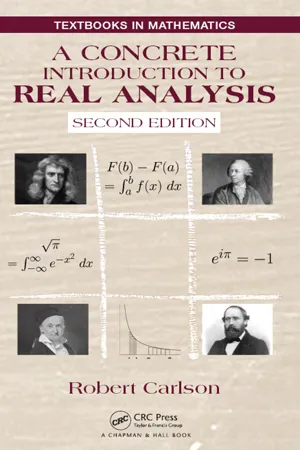
- 298 pages
- English
- ePUB (mobile friendly)
- Available on iOS & Android
A Concrete Introduction to Real Analysis
About this book
A Concrete Introduction to Analysis, Second Edition offers a major reorganization of the previous edition with the goal of making it a much more comprehensive and accessible for students.
The standard, austere approach to teaching modern mathematics with its emphasis on formal proofs can be challenging and discouraging for many students. To remedy this situation, the new edition is more rewarding and inviting. Students benefit from the text by gaining a solid foundational knowledge of analysis, which they can use in their fields of study and chosen professions.
The new edition capitalizes on the trend to combine topics from a traditional transition to proofs course with a first course on analysis. Like the first edition, the text is appropriate for a one- or two-semester introductory analysis or real analysis course. The choice of topics and level of coverage is suitable for mathematics majors, future teachers, and students studying engineering or other fields requiring a solid, working knowledge of undergraduate mathematics.
Key highlights:
- Offers integration of transition topics to assist with the necessary background for analysis
- Can be used for either a one- or a two-semester course
- Explores how ideas of analysis appear in a broader context
- Provides as major reorganization of the first edition
- Includes solutions at the end of the book
Frequently asked questions
- Essential is ideal for learners and professionals who enjoy exploring a wide range of subjects. Access the Essential Library with 800,000+ trusted titles and best-sellers across business, personal growth, and the humanities. Includes unlimited reading time and Standard Read Aloud voice.
- Complete: Perfect for advanced learners and researchers needing full, unrestricted access. Unlock 1.4M+ books across hundreds of subjects, including academic and specialized titles. The Complete Plan also includes advanced features like Premium Read Aloud and Research Assistant.
Please note we cannot support devices running on iOS 13 and Android 7 or earlier. Learn more about using the app.
Information
Table of contents
- Cover
- Half Title
- Title Page
- Copyright Page
- Table of Contents
- List of Figures
- Preface
- 1 Real numbers and mathematical proofs
- 2 Infinite sequences
- 3 Infinite series
- 4 More sums
- 5 Functions
- 6 Integrals
- 7 The Natural logarithm
- 8 Taylor polynomials and series
- 9 Uniform convergence
- A Solutions to odd numbered problems
- Bibliography
- Index